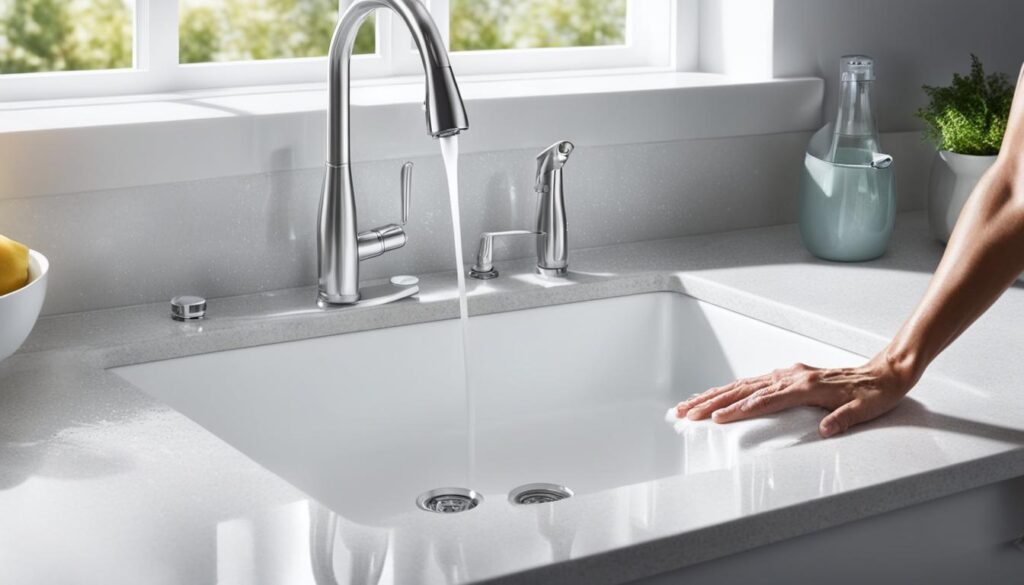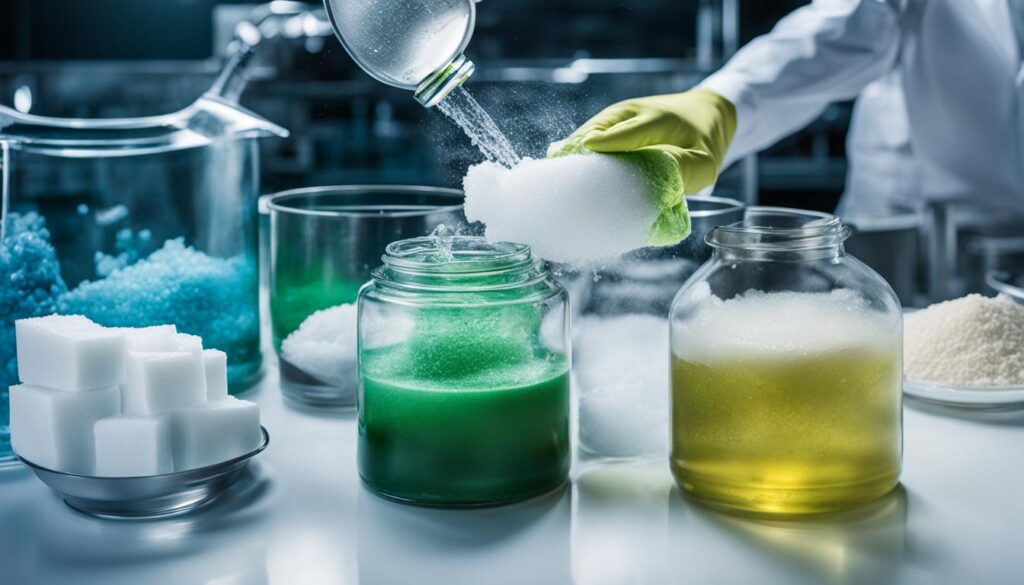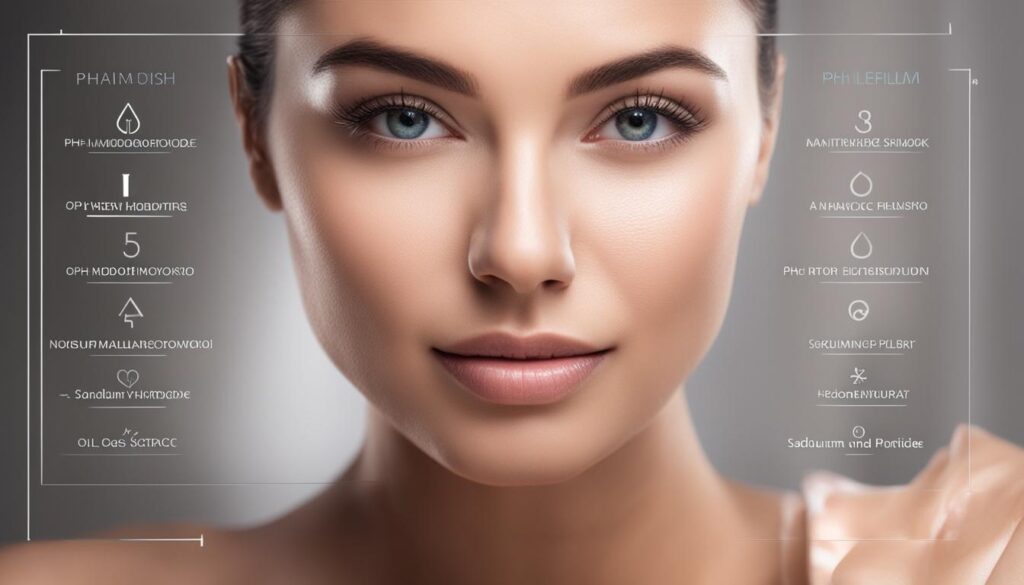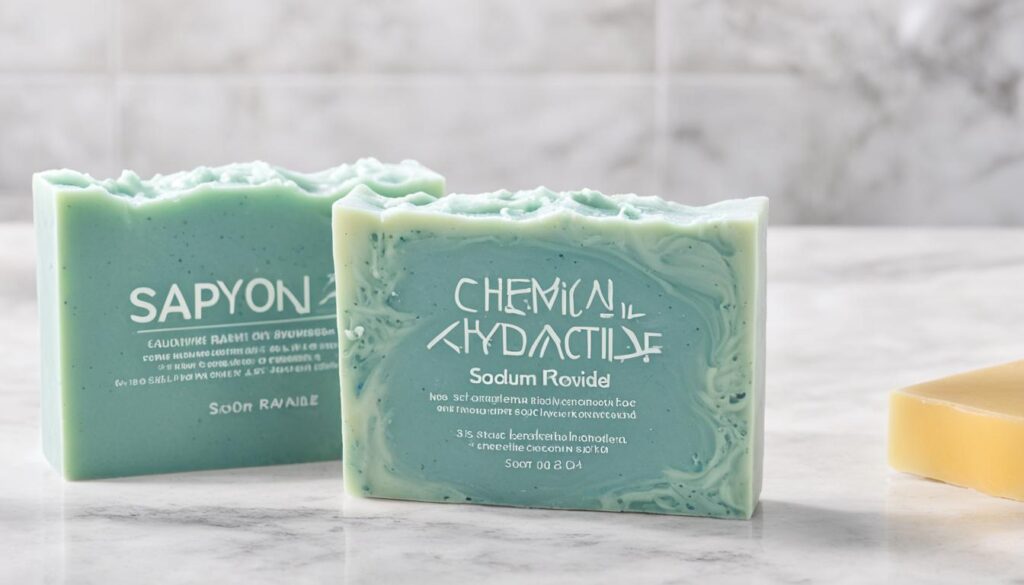Sodium hydroxide, also known as caustic soda or lye, offers a range of benefits in various industries, including skincare, cleaning, hair care, and soap making. It is produced through the electrolysis of brines and has a wide range of applications. When used in skincare products, sodium hydroxide helps to adjust the pH levels, ensuring the products are safe and effective. It also plays a crucial role in saponification, the process of turning fats and oils into soap. Additionally, sodium hydroxide is used in cleaning products and has applications in hair care, where it can help in maintaining the pH balance of the scalp.
Key Takeaways:
- Sodium hydroxide offers benefits in skincare, cleaning, hair care, and soap making.
- It helps adjust pH levels in skincare products, ensuring safety and efficacy.
- Sodium hydroxide plays a crucial role in saponification, turning fats and oils into soap.
- It is used in cleaning products for its effective removal of grease, oils, and stains.
- In hair care, sodium hydroxide helps maintain the pH balance of the scalp.
Sodium Hydroxide in Skincare
Sodium hydroxide plays a crucial role in skincare products, providing several benefits for the skin. One of its main functions is to adjust the pH levels of skincare formulations. Maintaining the appropriate pH is vital for ensuring that skincare products are safe and effective when applied to the skin. Sodium hydroxide helps to balance the pH and preserve the skin’s natural acid mantle, which acts as a protective barrier against allergens, pollutants, and bacteria.
By regulating the pH, sodium hydroxide contributes to the overall efficacy and compatibility of skincare products. It helps to optimize the skin’s response to active ingredients, enhancing their absorption and effectiveness. Additionally, sodium hydroxide aids in the formulation process by allowing oils and fats to emulsify and create stable and well-textured products.
In skincare, sodium hydroxide also participates in the saponification process. Saponification is the chemical reaction that occurs when fats or oils combine with an alkali, such as sodium hydroxide, to produce soap. This process creates cleansing and foaming properties in skincare products, ensuring they effectively remove impurities from the skin.
When used in controlled quantities, sodium hydroxide is considered safe for use in skincare products. Skincare manufacturers carefully measure and control the concentration of sodium hydroxide to ensure it is within safe and effective ranges. It is important to note that sodium hydroxide should be used under the guidance of skincare professionals and in compliance with product instructions.
The benefits of sodium hydroxide in skincare products make it a valuable ingredient for maintaining healthy and balanced skin. However, it is essential to perform a patch test before using any new skincare product to ensure compatibility and avoid potential allergic reactions.
Sodium Hydroxide in Cleaning Products

Sodium hydroxide offers a range of benefits in cleaning products due to its alkaline nature. It is known for its effectiveness in removing grease, oils, and stains from various surfaces, making it a popular ingredient in cleaning solutions, oven cleaners, drain cleaners, and detergents.
When used in cleaning products, sodium hydroxide acts as a powerful cleaner by breaking down and dissolving organic matter, making it easier to clean and remove tough stains. Its caustic properties enable it to cut through grime and dirt, providing deep cleaning action.
However, it is important to handle high concentrations of sodium hydroxide with caution as it can cause burns and skin irritation. Protective measures, such as gloves and goggles, should be used when using cleaning products containing sodium hydroxide to ensure safety.
Benefits of Sodium Hydroxide in Cleaning
Sodium hydroxide in cleaning products offers the following benefits:
- Effective removal of grease and oils: Sodium hydroxide’s alkaline properties make it highly effective in breaking down and removing stubborn grease and oils from surfaces.
- Stain removal: By dissolving organic matter, sodium hydroxide helps in the removal of tough stains, improving the overall cleanliness of surfaces.
- Deep cleaning action: Sodium hydroxide penetrates deep into surfaces, providing thorough cleaning and removing grime and dirt.
- Versatile use: In addition to general cleaning, sodium hydroxide can be found in specialized cleaning products for specific applications, such as oven cleaners and drain cleaners.
Overall, sodium hydroxide plays a significant role in maintaining cleanliness and hygiene by providing powerful cleaning capabilities in a wide range of cleaning products. However, it is crucial to handle and use sodium hydroxide-based cleaning products safely to prevent any potential risks or accidents.
| Advantages of Sodium Hydroxide in Cleaning Products | Considerations |
|---|---|
| Sodium hydroxide effectively removes grease and oils. | Caution must be taken when handling high concentrations of sodium hydroxide to avoid burns and skin irritation. |
| Sodium hydroxide aids in the removal of tough stains. | Protective measures such as gloves and goggles should be used when using cleaning products containing sodium hydroxide. |
| Sodium hydroxide provides deep cleaning action. | Tightly seal and store cleaning products containing sodium hydroxide out of reach of children. |
| Sodium hydroxide is versatile and can be found in specialized cleaning products. | Follow the instructions provided by the manufacturers when using cleaning products containing sodium hydroxide. |
Sodium Hydroxide in Hair Care

Sodium hydroxide, also known as caustic soda or lye, is not only beneficial for skincare but also finds its application in hair care products. In the field of hair care, maintaining the pH balance of the scalp is crucial for overall hair health. Sodium hydroxide plays a vital role in achieving and maintaining this balance. It is commonly found in shampoos and conditioners, where its properties contribute to effective cleansing and conditioning of the hair.
One of the key benefits of sodium hydroxide in hair care is its ability to remove dirt, oil, and product buildup from the hair and scalp. By doing so, it promotes a healthier scalp environment, which is essential for optimal hair growth and health. In addition, sodium hydroxide aids in maintaining the natural acidity of the scalp, contributing to balanced and healthy hair.
It’s important to note that sodium hydroxide in hair care products is carefully formulated in controlled quantities to ensure the safety and efficacy of the products. This allows for its benefits to be harnessed without causing harm to the hair or scalp.
Benefits of Sodium Hydroxide in Hair Care:
- Effective cleansing of hair and scalp
- Removal of dirt, oil, and product buildup
- Promotion of a healthier scalp environment
- Maintenance of the natural acidity of the scalp
| Hair Care Benefits of Sodium Hydroxide | Details |
|---|---|
| Effective Cleansing | Sodium hydroxide assists in thoroughly cleansing the hair and scalp, removing impurities and buildup. |
| Removal of Dirt and Oil | By effectively removing dirt and excess oil, sodium hydroxide helps maintain a clean and fresh scalp. |
| Promotes Scalp Health | Sodium hydroxide creates an environment that is conducive to a healthy scalp, contributing to overall hair health. |
| Maintains pH Balance | By balancing the pH levels of the scalp, sodium hydroxide helps maintain the natural acidity required for healthy hair. |
Sodium Hydroxide in Soap Making

Sodium hydroxide, also known as caustic soda or lye, plays a crucial role in the process of soap making. It is used in a chemical reaction called saponification, which converts fats and oils into soap molecules. The interaction between sodium hydroxide and the fatty acids in the oils and fats results in the creation of solid and liquid soaps with cleansing and foaming properties.
The saponification process begins by carefully measuring and combining sodium hydroxide with water, creating a sodium hydroxide solution. This solution is then added to a mixture of oils and fats. As the sodium hydroxide reacts with the fatty acids, soap molecules are formed, while glycerin is released as a byproduct.
“The saponification process, driven by sodium hydroxide, is a chemical reaction that has been used for centuries to create soap.”
Soap made through this process can be customized by selecting different types of oils and fats and adjusting the amounts of sodium hydroxide used. This allows soap makers to create various textures, scents, and properties in their soap products.
It is important to note that handling sodium hydroxide requires caution, as it is highly caustic in its pure form. Safety measures, such as wearing gloves and protective eyewear, should be followed when working with sodium hydroxide for soap making.
Benefits of Sodium Hydroxide in Soap Making:
- Creates solid and liquid soaps with cleansing and foaming properties
- Allows customization of soap products with different oils and fats
- Enables the creation of various textures, scents, and properties in soap
In summary, sodium hydroxide plays an essential role in soap making by facilitating the saponification process. Its chemical reaction with fats and oils results in the creation of soap molecules, leading to the production of solid and liquid soaps. While sodium hydroxide should be handled with care, its benefits in soap making contribute to the creation of high-quality soap products.
Safety Considerations with Sodium Hydroxide

While sodium hydroxide offers various benefits, it is important to handle it with caution due to its caustic nature. Concentrated amounts of sodium hydroxide can cause chemical burns and skin irritation. It is crucial to avoid direct contact with pure sodium hydroxide and to use protective measures, such as gloves, when handling cleaning products that contain sodium hydroxide. In skincare products, sodium hydroxide is used in low doses that are generally completely used up in the reaction process, making it safe for use on the skin.
When working with concentrated sodium hydroxide, it is essential to follow proper safety protocols. Consider the following precautions:
- Always wear protective gloves and safety goggles when handling sodium hydroxide.
- Avoid inhaling sodium hydroxide fumes or getting it in contact with your eyes.
- If you have a skin contact with sodium hydroxide, wash the affected area thoroughly with water and seek medical attention if necessary.
- If swallowed, do not induce vomiting and seek immediate medical help.
Sodium hydroxide products should be stored in a cool, dry place, away from direct sunlight and heat sources. Keep them out of reach of children and pets to prevent accidental ingestion or contact.
“Sodium hydroxide is a powerful chemical compound that requires careful handling. By following the proper safety precautions, you can enjoy the benefits of sodium hydroxide without compromising your well-being.” – Dr. Lisa Reynolds, Dermatologist
Other Applications of Sodium Hydroxide

In addition to its versatile uses in skincare, cleaning, hair care, and soap making, sodium hydroxide finds application in various other industries and processes. Its unique properties make it an indispensable ingredient in many different areas.
One of the significant applications of sodium hydroxide is in the production of paper and aluminum. In the paper manufacturing process, sodium hydroxide is used to break down lignin, a complex organic substance found in wood, allowing the separation of cellulose fibers to create paper. Similarly, sodium hydroxide is involved in the extraction of aluminum from its ore, bauxite, through a process called the Bayer process.
Sodium hydroxide also plays a crucial role in the manufacturing of textiles, including viscose rayon. It assists in dissolving cellulose, a fibrous organic compound found in plants, to create the necessary raw materials for producing textile fibers.
Moreover, sodium hydroxide is utilized in the production of dyes. It helps to adjust the pH levels during the dyeing process, ensuring optimal color absorption and fixation onto the fabric or material being dyed.
Another prominent application of sodium hydroxide lies in the pharmaceutical industry. It is used in the production of various medicines, including certain antibiotics and pain relievers, as well as in the manufacturing of soaps and detergents.
Furthermore, sodium hydroxide is involved in water treatment processes. It is used to adjust the pH levels of water by neutralizing acidity or alkalinity, making it suitable for consumption. Additionally, sodium hydroxide aids in the removal of impurities, such as heavy metals and organic matter, from water during the purification process.
“Sodium hydroxide’s versatility and wide-ranging applications make it an invaluable ingredient in various industries, including paper production, aluminum extraction, textile manufacturing, dyeing, pharmaceuticals, and water treatment processes.”
| Industry | Application |
|---|---|
| Paper | Used to break down lignin in wood during the paper manufacturing process. |
| Aluminum | Involved in the extraction of aluminum from bauxite in the Bayer process. |
| Textiles | Used to dissolve cellulose and create raw materials for textile fibers. |
| Dyes | Aids in adjusting pH levels during the dyeing process for optimal color absorption. |
| Pharmaceuticals | Utilized in the production of certain medicines, soaps, and detergents. |
| Water treatment | Adjusts pH levels and removes impurities in the purification process. |
The Importance of pH Balance in Skincare

Maintaining the appropriate pH balance in skincare products is essential for optimal skin health. The skin’s natural pH is slightly acidic, typically ranging from 4 to 7. When the pH balance is disrupted, it can lead to various skin issues, including dryness, sensitivity, and acne.
Sodium hydroxide helps to adjust the pH levels in skincare products to ensure that they are compatible with the skin’s natural acidity. By carefully balancing the pH, sodium hydroxide plays a vital role in maintaining the skin’s protective barrier, known as the acid mantle. This barrier helps to shield the skin from external aggressors such as allergens, pollutants, and bacteria.
Additionally, sodium hydroxide’s role in skincare extends to saponification, a chemical process that occurs when making soap. When combined with fats and oils, sodium hydroxide converts them into soap molecules, creating a cleansing and foaming action.
“Maintaining the appropriate pH balance in skincare products is crucial for healthy skin. Sodium hydroxide helps to adjust the pH levels, preserving the skin’s protective barrier and promoting overall skin health.”
Using skincare products formulated with sodium hydroxide can provide numerous benefits. It ensures that the products are effective in their intended use, whether it’s cleansing, exfoliating, or moisturizing. The balanced pH level also enhances the skin’s absorption of other beneficial ingredients, maximizing the skincare routine’s overall efficacy.
Sodium hydroxide in skincare should be used in controlled quantities as prescribed by the product manufacturer. When used appropriately, it is considered safe for use on the skin. However, it is always advisable to consult a dermatologist if you have any concerns or existing skin conditions before incorporating sodium hydroxide-containing products into your skincare routine.
Overall, the importance of maintaining the appropriate pH balance in skincare cannot be understated. Sodium hydroxide’s role in adjusting pH levels contributes to the overall health and well-being of the skin, ensuring that skincare products are effective, gentle, and compatible with the skin’s natural acidity.
The Role of Sodium Hydroxide in Saponification

Saponification is a chemical process that plays a crucial role in the creation of soap. This transformation occurs through a reaction between sodium hydroxide and the fatty acids found in oils and fats. The result of this reaction is the formation of soap molecules, which possess cleansing and foaming properties. Without the presence of sodium hydroxide, the oils and fats would not be able to combine effectively to create a cohesive soap product. It is important to highlight that the saponification process requires precise measurements and careful handling of sodium hydroxide.
How Saponification Works
During the saponification process, sodium hydroxide, also known as lye, breaks down the ester bonds in the oils and fats. This hydrolysis reaction separates the fatty acids from the glycerol backbone, allowing them to react with sodium hydroxide. The reaction between the fatty acids and the sodium hydroxide forms soap molecules, which are a combination of the fatty acid salts and glycerol. These soap molecules have both hydrophilic (water-attracting) and hydrophobic (oil-attracting) properties, making them effective at removing dirt, oil, and impurities from surfaces and skin.
The Importance of Precise Measurements
When working with sodium hydroxide in soap making, precise measurements are crucial to ensure the safety and effectiveness of the final product. The amount of sodium hydroxide used must be carefully calculated to achieve the desired level of saponification without leaving excess lye in the soap. Too much sodium hydroxide can result in a harsh and drying soap, while too little can result in an unsatisfactory lather and less effective cleansing properties. Soap makers often use precise calculations and ratios to ensure the optimal balance of oils, fats, and sodium hydroxide in their recipes.
The Role of Sodium Hydroxide in pH Adjustment
Aside from its primary role in saponification, sodium hydroxide also plays a secondary role in adjusting the pH of the soap. The saponification reaction initially produces a soap mixture with a high pH, making it alkaline. To achieve a pH that is safe and gentle for the skin, additional pH adjustments may be necessary. Soap makers can add acids, such as citric acid or lactic acid, to neutralize the soap and bring it to a desired pH range, typically between 8 and 9. This pH adjustment is essential to ensure that the soap is mild and non-irritating to the skin.
| Benefits of Sodium Hydroxide in Soap Making |
|---|
| Saponification: Enables the transformation of oils and fats into soap molecules with cleansing and foaming properties. |
| Precise Measurements: Requires accurate calculations to achieve the desired lye-to-oil ratio for optimal soap quality. |
| pH Adjustment: Allows soap makers to neutralize the alkaline soap and bring it to a skin-friendly pH range. |
Using Sodium Hydroxide Safely in Skincare
When it comes to incorporating sodium hydroxide into your skincare routine, safety should be a top priority. While this powerful ingredient offers numerous benefits, it’s important to handle it with care and use it in controlled quantities to ensure optimal results. By following recommended guidelines and taking necessary precautions, you can enjoy the advantages of sodium hydroxide while keeping your skin healthy and well-protected.
First and foremost, always read and follow the instructions provided by the product manufacturer. These instructions will guide you on the proper usage and application of skincare products containing sodium hydroxide. Pay attention to recommended amounts and frequencies to avoid overexposure or potential side effects.
It’s also advisable to conduct a patch test before using a new product that contains sodium hydroxide, particularly if you have sensitive skin. Apply a small amount of the product to a discreet area of your skin, such as the inner arm, and observe for any adverse reactions. If you experience redness, itching, or irritation, discontinue use immediately and consult a dermatologist for further guidance.
“Safety should always be a top priority when incorporating sodium hydroxide into your skincare routine.”
Furthermore, it’s important to store sodium hydroxide skincare products properly and keep them out of the reach of children. As with any chemical substance, accidental ingestion or contact can be harmful. Keep your skincare products in a cool, dry place, away from direct sunlight and moisture, to maintain their efficacy and safety.
| Safe Use Tips for Sodium Hydroxide in Skincare |
|---|
| 1. Follow product instructions: Read and adhere to the recommended guidelines provided by the manufacturer. |
| 2. Conduct a patch test: Test the product on a small area of skin before widespread use to check for potential adverse reactions. |
| 3. Store properly: Keep sodium hydroxide skincare products in a cool, dry place, out of reach of children. |
| 4. Discontinue use if needed: If you experience any discomfort or adverse effects, stop using the product and seek professional advice. |
By using sodium hydroxide safely in your skincare routine, you can enjoy the benefits it offers without compromising your skin’s health. Remember to prioritize safety, be mindful of product instructions, and listen to your skin’s reactions. When used responsibly, sodium hydroxide can be a valuable asset in achieving your skincare goals.
Conclusion
Sodium hydroxide offers a range of benefits in various industries, including skincare, cleaning, hair care, and soap making. When used in controlled quantities, sodium hydroxide helps adjust the pH levels in skincare products, aids in saponification, and contributes to the cleansing and conditioning properties of hair care products. However, it is important to handle sodium hydroxide with caution due to its caustic nature. Consult a dermatologist before making any significant changes to your skincare routine, especially if you have sensitive skin or any skin conditions.
FAQ
What are the benefits of sodium hydroxide?
Sodium hydroxide offers a range of benefits in various industries, including skincare, cleaning, hair care, and soap making. It helps adjust the pH levels in skincare products, aids in saponification in soap making, and contributes to the cleansing and conditioning properties of hair care products.
How is sodium hydroxide used in skincare?
Sodium hydroxide is used in skincare products in small and controlled quantities to adjust the pH levels. It helps maintain the skin’s acid mantle, acts as a protective barrier against allergens and bacteria, and promotes a cleansing effect.
What are the uses of sodium hydroxide in cleaning products?
Sodium hydroxide is widely used in cleaning products due to its alkaline nature. It effectively removes grease, oils, and stains from various surfaces and can be found in cleaning solutions, oven cleaners, drain cleaners, and detergents.
How does sodium hydroxide benefit hair care?
Sodium hydroxide helps to maintain the pH balance of the scalp in hair care products. It removes dirt, oil, and product buildup from the hair and scalp, promoting a healthier scalp environment and overall hair health.
What is the role of sodium hydroxide in soap making?
Sodium hydroxide is essential in the saponification process of soap making. It reacts with the fatty acids in oils and fats, forming soap molecules and creating a cleansing and foaming action.
How can sodium hydroxide be used safely?
Sodium hydroxide should be handled with caution due to its caustic nature. Concentrated amounts can cause burns and skin irritation. It is important to use protective measures and follow instructions when handling products containing sodium hydroxide.
What are the other applications of sodium hydroxide?
Sodium hydroxide is used in the production of paper and aluminum, as well as in the manufacturing of textiles, dyes, and pharmaceuticals. It is also used in water treatment processes to adjust pH levels and remove impurities.
Why is pH balance important in skincare?
Maintaining the appropriate pH balance in skincare products is essential for optimal skin health. The skin’s acid mantle acts as a protective barrier, and disruptions in pH can lead to various skin issues such as dryness, sensitivity, and acne.
What is the role of sodium hydroxide in saponification?
Sodium hydroxide plays a crucial role in the saponification process by reacting with the fatty acids in oils and fats, resulting in the formation of soap molecules.
Can sodium hydroxide be used safely in skincare?
When used in controlled quantities, sodium hydroxide is generally safe in skincare products. It is important to follow instructions, conduct patch tests, and discontinue use if adverse reactions occur. However, consultation with a dermatologist is recommended, especially for those with sensitive skin or existing skin conditions.






